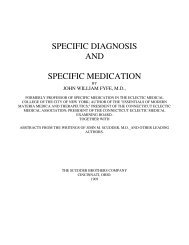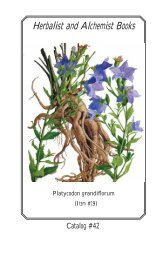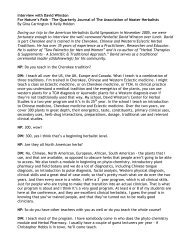MEDlCINAL PLANTS OF JAMAICA. PARTS 1 & 11.
MEDlCINAL PLANTS OF JAMAICA. PARTS 1 & 11.
MEDlCINAL PLANTS OF JAMAICA. PARTS 1 & 11.
Create successful ePaper yourself
Turn your PDF publications into a flip-book with our unique Google optimized e-Paper software.
SOLANUM NIGRUM L. Branched Calalu; Guma; Black Nightshade.<br />
This plant has long been in use in Jamaica as a green vegetable and potherb. Both Browne and Lunan<br />
mention it under the common name of branched calalu. It is said to be good for the blood and as an aperient.<br />
Steggerda mentions its use for mouth sores. The leaves and berries, especially when unripe, contain the alkaloid<br />
solanine and the plant, although poisonous in Europe, appears to be harmless in Jamaica and South Africa. In<br />
Africa both this and a number of other species of Solanum are used like spinach. In addition to solanine the<br />
plant is said to contain an unidentified alkaloid, saponin and betaine. In Africa and Jamaica the leaves have, or<br />
have had, a reputation as a local anodyne for inflammation. The plant is also employed for treatment of fevers<br />
of various kinds. A paste of the green berries is used by the Zulus for ringworm. (See S. aculeatissimum). (2, 5,<br />
15, 25, 26, 27).<br />
STERCULIACEAE<br />
About one thousand, mainly tropical. woody and herbaceous species are contained in this family. Only<br />
the genera Cola and Theobroma, which contain characteristic alkaloids, are chemically well known. The<br />
principle alkaloids are caffeine (theine) and theobromine. It has also been said by some workers that glucosides<br />
occur. Other substances which have been identified are kolatannin, tannins, asparagine, kola and cacao red,<br />
organic acids, gums and a variety of enzymes. Fats are in some cases of commercial importance, e.g. cocoa<br />
butter.<br />
COLA ACUMINATA Schott and End!. Cola (Kola); Bissy (Bichy, Busy) Nut.<br />
Cola nuts are used in Jamaica for stomach pains and as a purge when poison is suspected. The nuts are<br />
grated and boiled like coffee or taken with strong rum. A little cola is sometimes added to country chocolate and<br />
it is considered to allay hunger. The plant is said by Lunan to have been brought to Jamaica from the Guinea<br />
Coast and planted out near Guanaboa by one Mr. Goffe. In Africa the nut is chewed to promote digestion, is<br />
considered to be a tonic, stimulating and antiperiodic, and is also used in dysentery. The chemical composition<br />
of cola nuts appears to be complex and a matter for some difference of opinion. 11 is stated that I to 2.35 per<br />
cent of caffeine and a small amount of the bromine are present. Starch makes up about 46 per cent of the dry<br />
nut; glucose and sucrose are present; fats (up to 3 per cent) tannin and gum are found. Early work indicated<br />
the presence of a compound called kolatine said to be a tanno-glucoside or a catechin compound but this has not<br />
been found by subsequent investigators. Kolanine, described in earlier work as a glucoside splitting up into<br />
caffeine, glucose and kola red. and occurring principally in fresh nuts, was later said to be a mixture of caffeinetannate<br />
and theobromine-tannate, the latter being a glucoside. Kola red may also be a glucoside, giving rise to<br />
phloroglucin. In 1929, Casparis found that the drug contained kolacatechin (C 20H 20H 83H 20) and free caffeine<br />
the kolacatechin being mainly oxidised to kola red. Kolatine was not found in the fresh nuts but caffeinekolacatechin<br />
(C 28H 30N 4O 10) was said to be present. (2, 7, 8, 10, 15, 23, 24, 27).<br />
HELICTERES JAMAICENSIS Jacq. Corkscrew; Screw Tree.<br />
With the wood and leaves, which are bitter, a tea is made for biliousness. Beckwith mentions the use of<br />
corkscrew, an unidentified plant but probably this species, as an emetic. In MacFadyen's day an infusion was<br />
used for fever, coughs and tuberculosis. (2, 16, 8).<br />
MELOCHIA TOMENTOSA L. Tea Bush; Raichie.<br />
Used to make tea for colds.<br />
WALTHERIA AMERICANA L. Raichie.<br />
This plant provides a tea for colds. In the Grenadines it is said 'to increase the blood'. In Africa it has a<br />
varied reputation, being used as a remedy for sterility and internal haemorrhage and by others to cause abortion.<br />
It is a common children's remedy and is also used for coughs, as a restorative, and for the prevention of syphilis.<br />
It is said to contain tannin, mucilage and sugar. (7, 13).







